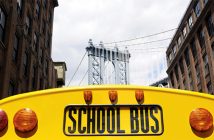 (Photo: Flickr, Creative Commons)
(Photo: Flickr, Creative Commons)
Published as a joint effort by the 21st Century School Fund, Inc., the U.S. Green Building Council, Inc., and the National Council on School Facilities, the 2016 State of Our Schools report attempts to answer the question of where our country stands in terms of offering a high-quality education to all students in a safe and healthy environment.
The report, “State of Our Schools: America’s K–12 Facilities,” puts data together in a state-by-state analysis, resulting in the creation of a standards-based framework through which the nation’s education investment can be benchmarked.
The authors created a common fact base in order to better understand three important points, including the scale of elementary and secondary public school infrastructure; the efforts of communities to offer a safe, healthy, and quality public school facility; and the investment that is still needed in order to ensure adequate and equal public school facilities for all students.
According to an independent study commissioned in 2015 by the US Green Building Council, 92% of Americans believe that public school buildings are in need of improvements.
Research has shown that high-quality K-12 public school buildings result in higher student achievements, a reduction in truancy and suspensions, improved satisfaction among staff members, and increased property values. In addition, the authors say infrastructure is important to ensure equity in educational offerings and opportunities for students.
The authors suggest four ideas to help states begin a discussion that will lead to every child attending a quality school in a safe and healthy facility that is conducive to learning.
First, the authors say states must understand the conditions currently existing in their own schools and how these schools affect student and teacher health and performance, as well as the environment, the local economy, and the overall vitality of the community. In order to do this, up-to-date, comprehensive, and accurate data pertaining to public school infrastructure must be made available.
Second, the general public must be made aware of the value of having a safe and healthy environment for learning. The authors suggest that plans for fixing poor conditions and inequities be made systematically and priorities be identified.
The authors continue to say that enough public funding must be offered in order to make it possible to meet the responsibilities of the country to students currently enrolled and those to come after them. They suggest the federal government find ways to help reduce the inequities in the conditions of school facilities.
Lastly, the authors write that public and private resources need to be leveraged in order to create high-quality school buildings in every district.
“As a nation, we have the will, but we must find the way. We invite problem-solvers from communities, government, industry and academia to use the framework and data in this report to develop creative solutions for improving our K–12 infrastructure. Together, let us secure new revenue streams and leverage public and private resources to provide the best educational opportunities for our nation’s students — all of them.”




